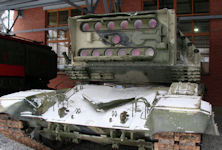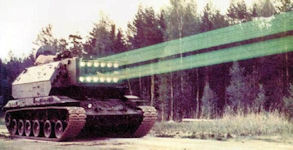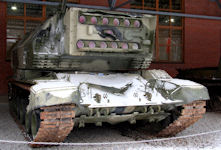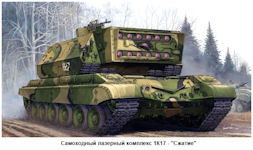1K17 Szhatiye "Compression"
The pinnacle of Soviet physicists’ laser research was the 1K17 Szhatiye (compression) project which went into service in 1992. While resembling the Buratino (Pinocchio) salvo-firing rocket and heavy flamethrower systems, Szhatiye’s 12 barrels did not hold rockets but multi-line lasers. Each had its own frequency band and internal guidance system, which were impervious to enemy filter systems.
In 1991, a specially packaged chassis and derivative of the Msta-S self-propelled howitzer installed a package of lasers. The resulting car was called 1K17 "Compression". The photographs show that the self-propelled gun had 12 lasers (two rows of six) and associated optics: a laser range finder, an aiming lens and two sight (day and night). Each laser has its own drives for aiming.
A dozen individual lenses amplified the main beam as huge batteries allowed the vehicle to fire multiple “shots” in rapid succession. “[The] laser guns … were capable of burning out all enemy optics within direct line of sight in fractions of a second,” the newspaper wrote. “When there was contact with enemy armored vehicles, Soviet laser tanks simply would blind them, making aimed fire impossible,” Rossiyskaya Gazeta wrote. The energy beam would have twice the range of a normal tank gun.
The weapon comprised a solid-state laser with fluorescent energizing lights similar to those of the American ZEUS remote demining system. Because of its powerful generator and power plant, Szhatiye was mounted on the chassis of the heavy Msta-S self-propelled gun. The system is still classified and there is no open data on characteristics like the range, firing rate or number of simultaneously engaged targets.
Potential targets of the laser complex "Compression" - tanks, self-propelled artillery systems and even low-flying helicopters. Having discovered the target by means of radar, the complex produced its laser sounding, trying to detect optical equipment through blinking lenses. Locally localizing the "electronic eye", the device hit it with a powerful laser pulse, blinding or burning out the sensing element (photocell, photosensitive matrix or even the retina of the sighted fighter). The range of the laser is classified information. However, it is known that the previous version of the complex - "Stiletto" - could hit targets at a distance of up to ten kilometers, that is, practically at any distance from which the object was visible.
Its range may be presumed to be no less than Sanguine’s, so twice the effective range of a modern tank. But while impressive on the drawing board, this must be set against the laser’s main disadvantage: the need for a clear line of sight in order to hit a target. Shooting at point-blank range in combat conditions is also hampered by terrain relief, rendering such systems largely impractical.
But as evidenced by U.S. and Chinese activity, the use of lasers against guided missiles, helicopters and UAV drones (where using conventional missiles is prohibitively expensive), is a strong incentive for further development.
In 1992, the first prototypes rolled out of the factory, but the economic chaos in the wake of the Soviet collapse forced the government to cancel the program. “But one high-ranking official of the Yeltsin government once publicly let it slip that platforms were practically ready,” Rossiyskaya Gazeta noted. “The technology has not been lost.”
“There are a handful of areas … where, theoretically, Soviet-era engineering remains competitive on today’s battlefield,” retired US Army Major Ray Finch, - an analyst at the Army’s Foreign Military Studies Office, — wrote in the June 2015 edition of OE Watch. There are two versions of the lasers themselves : one for each, specifically for "Compression", a dozen of 30-kilogram ruby crystals were grown in the laboratory, on the other - a non-ruby laser, and the so-called Nd: YAG (solid-state laser based on aluminum-yttrium garnet with additives of neodymium). Nevertheless, both options would cost the manufacturer a pretty penny and required a lot of energy.
To supply the lasers with electricity, Compression had an additional power unit, which set in motion a special generator. State tests of the machine, judging by the recommendations for adoption, were successfully carried out. However, it seems that the matter has come to an end. The USSR collapsed, and it was no longer up to the "Compression".
|
NEWSLETTER
|
| Join the GlobalSecurity.org mailing list |
|
|
|





